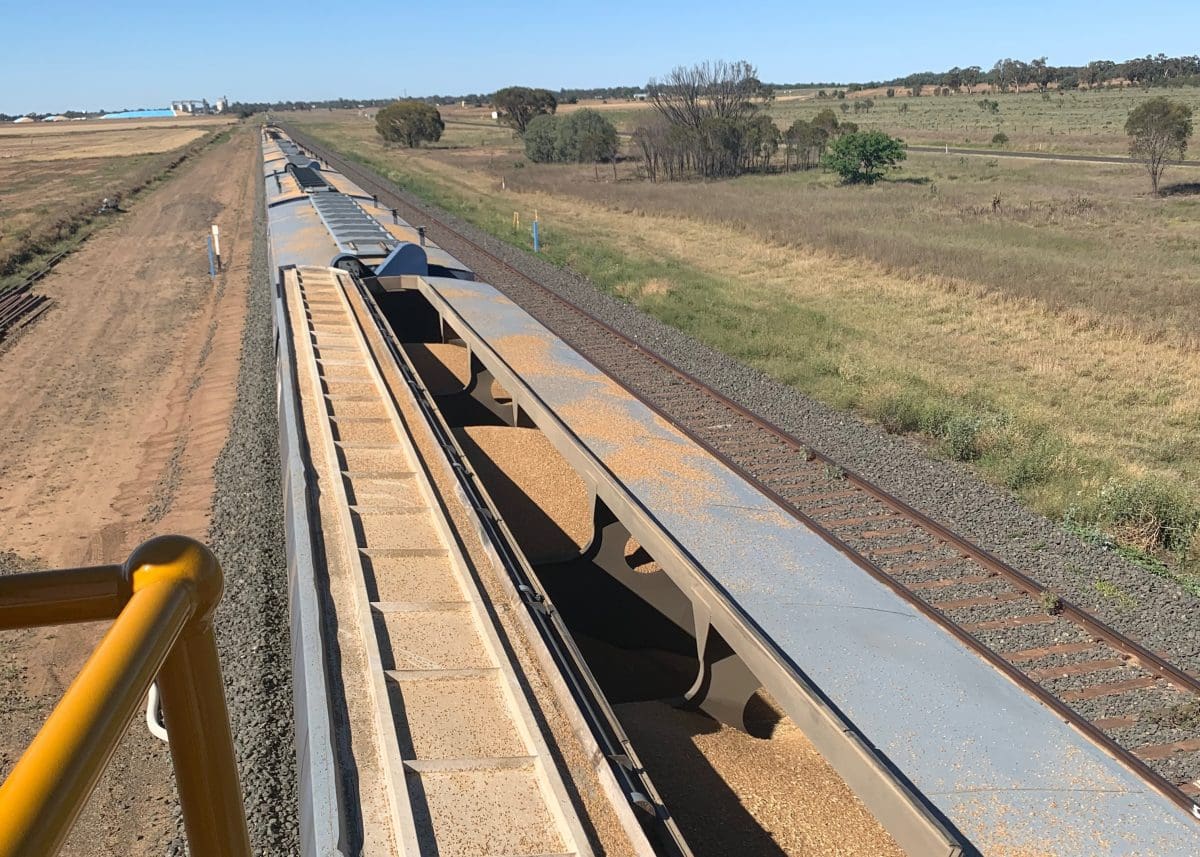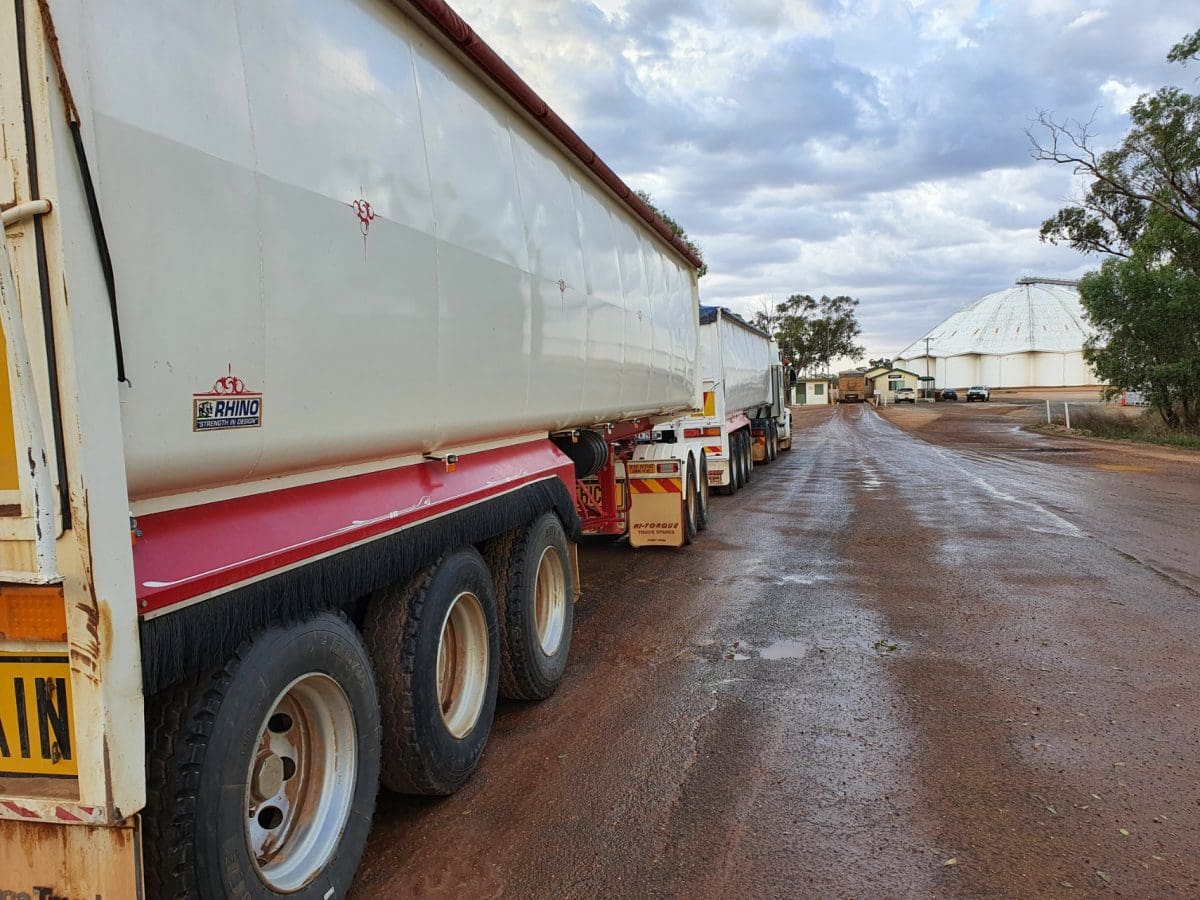
Qube’s first grain train for the 2020 harvest departed from QubeAgri at Coonamble yesterday bound for Quattro Ports grain terminal at Port Kembla. Photo: Qube Agri
COMPETITION between the export and domestic markets is supporting values for wheat in mostly thin trade.
On barley, results of the latest Saudi Arabian tender came in at a few dollar per tonne over Monday’s domestic cash bids, which have now bounced up to better compete with export parity.
On the harvest front, Queensland is almost done, while in New South Wales, the main game is rolling south from northern to central districts, where some growers already have up to 40 per cent of their crop in the bin, silo or bunker.
Victorian growers are making speedy progress on their harvest in the state’s earlier areas, and a reasonable amount of grower selling has seen the January market soften, and the inverse all but collapse.
Logistics is proving tricky this week, with a four-day scheduled rail-maintenance shutdown pausing train movement to the Port of Newcastle (see statement below from ARTC), and consumers scrambling for road freight.
| This week | Last week | Change | |
| Barley Downs Nov | $270 | $262 | Up |
| Barley Downs Jan | $270 | $258 | Up |
| Barley Melbourne Nov | $250 | $245 | Up |
| Barley Melbourne Jan | $240 | $240 | Steady |
| Wheat Downs Nov | $302 | $307 | Down |
| Wheat Downs Jan | $300 | $300 | Steady |
| Wheat Melbourne Nov | $310 | $345 | Down |
| Wheat Melbourne Jan | $304 | $305 | Down |
| Sorghum Downs Mar-Apr | $312 | $295 | Up |
Table 1: Indicative delivered grain prices in AUD per tonne.
Sites filling fast
Storages in the northern half of NSW are full, or close to it, as the supply chain backs up ahead of vessels arriving to load new-crop grain.
“Sites are filling up, and how that plays out will be interesting,” Agmark director Richard Alcorn said.
Some consumers are scrambling for enough grain to fill requirements up to Christmas, with a tight supply of road freight being the major constraint.
“The shortage of trucks is causing a lot of problems for delivering to feed buyers.”
An ample supply of Prime Hard (PH) wheat has seen its premium over APW sink and flatline at around $6-7/t in the past couple of weeks.
Transport operators are flat out servicing clients on short cycles — either within farm boundaries or from farm to local depot — and rates for longer cycles are firming as buyers bid up the business.
“The whip hand is definitely held by the trucking industry at the moment.
“There are prompt premiums to get grain to Newcastle, and that’s likely to be the case up to Christmas.”

Rain last week slowed or stopped deliveries at some sites in NSW including GrainCorp at Tottenham. Photo: Mark Mortimer
Northern feed limited
The poultry sector is a keen buyer of weather-damaged wheat, with low falling numbers caused by rain at harvest the major reason for downgrading to date.
“Feed grades are holding up reasonably well, and the poultry industry has been sopping up what it can, but there’s not much of it.”
Short rain delays at the end of last week have further tightened nearby supply.
This means cattle feeders are buying PH-type wheat to feed now that barley supplies on and north of the NSW-Queensland border tighten.
Feedlots on the Darling Downs are pulling wheat and barley from districts including Coonamble and Moree to fill prompt requirements.
Harvest on the Liverpool Plains is now under way, and consumers in and near Tamworth are now able to source local grain instead of dragging it by road from the north-west plains.
The inverse for nearby grain over the January market prevails as domestic feed and flour millers find grain harder to procure than was expected a few weeks ago.
Robinson Grain wheat trader Jock Benham said many consumers were still buying hand to mouth amid limited supplies of feed wheat.
“There hasn’t been much lower-quality wheat come forward for feed, and they’re having to buy to buy H2 or even PH.
“Domestic guys are certainly hoping for some lower-quality wheat to come forward, but we’re still meeting quality for export,” Mr Benham said.
Some sites close to Dubbo are getting full as harvest moves into mixed-farming rather than continuous-cropping areas.
“There are good yields and good quality coming off this harvest; the only issue is delivering it.”
Southern pace picks up
In southern NSW, harvest is well under way on the outer south-west and southern slopes, with growers around West Wyalong, Ardlethan and Coolamon going flat out ahead showers forecast for Sunday and Monday.
At Culcairn in the eastern Riverina, Godde’s Grain trader Peter Gerhardy said canola and barley harvest had started, and some early barley samples were showing high screening and low testweights.
“Colour is a bit of a problem too; there’s some staining.”
Competition from ryegrass, frost and excessive grazing pressure are all possible reasons for high screenings and testweights below around 63kg per hectolitre, while late rain has caused the discolouration.
“We’re seeing a little bit of downgraded barley with a low testweight and some high screenings,” Mr Gerhardy said.
“That high-screenings barley is no good for roller mills.
“It can only be used by people who can hammermill it, and it’s selling for a discount of about $30 to BAR1.”
APW wheat in southern NSW is trading at around $260/t local depot, while barley is selling for $180-$190/t.
“That spread’s too wide.”
Mr Gerhardy said the market was trying to figure out which way it would narrow.
“Is wheat going to come down, or is barley going to come up?”
Mr Gerhardy said lack of space at storages and limited truck availability were already looming as problems in southern NSW as the peak harvest period neared.
In the sorghum market, new-crop demand from China has lifted values by around $20/t in the past week.
RTC are currently undertaking a major maintenance shutdown on the Hunter Valley Network from Newcastle to Ulan and Turrawan, which is set to be completed early tomorrow morning (Friday 20 November).
Hunter track reopens tomorrow
ARTC controls and maintains the rail line which primarily carries coal from north-west NSW to the Port of Newcastle, and is also an important artery for exported grain.
“ARTC is currently undertaking a major maintenance shutdown on the Hunter Valley Network from Newcastle to Ulan and Turrawan, which is set to be completed early tomorrow morning,” an ARTC spokesperson said.
“The shutdown has been planned for the past 18 months in consultation with industry and stakeholders to ensure minimal disruption.
“Over the past four months we have held multiple meetings with councils, rail providers, grain growers and other stakeholders to communicate our plans for this period, and ensure these groups had visibility over the schedule of the works.
“This shutdown will ensure better network availability during grain season, as the alignment of maintenance windows the entire way to the port will minimise the need for additional track possessions.”
Grain Central: Get our free cropping news straight to your inbox – Click here



HAVE YOUR SAY